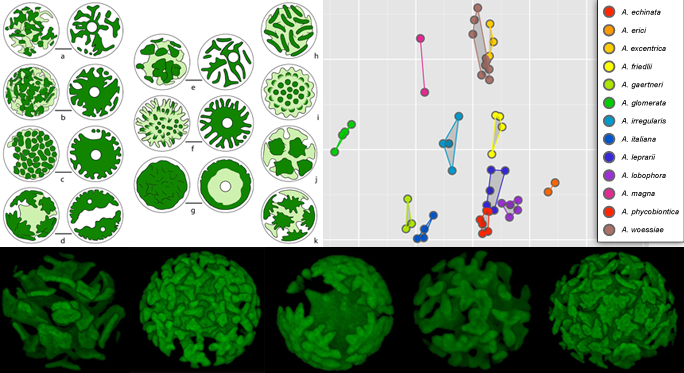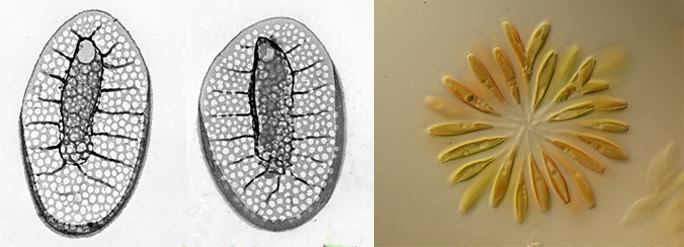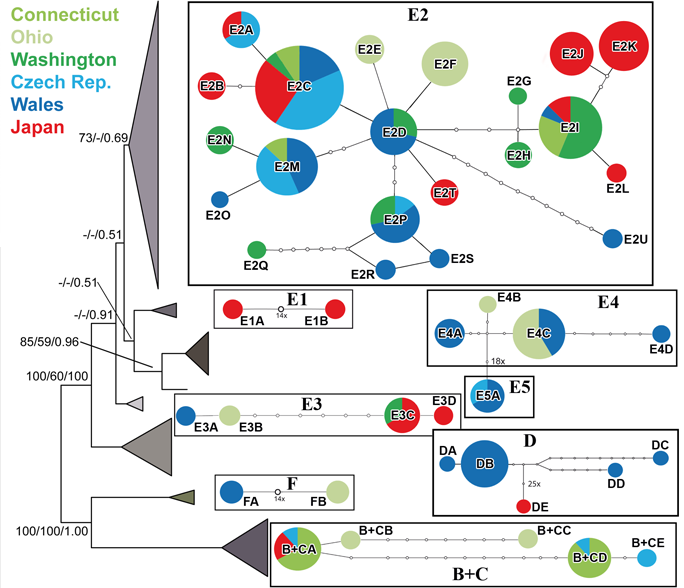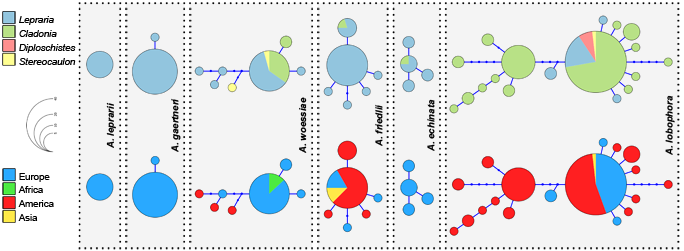Research Topics
 |
 |
 |
 |
 |
Evolution and morphological diversification of young species complexes
Microbial eukaryotes (protists) often have few morphological characters, thus their morphological species identification is very difficult. Contrary to the situation for macroorganisms, convergent morphological evolution leads to similar and simple morphologies across lineages. Molecular data give us an insight into the real evolution and morphological diversification of microbial eukaryotes, which are often in strong contradiction with our traditional conception. In fact, very little is known about morphological evolution of protists, in part due to the scarcity of fossil data. Ancestral state reconstruction techniques, however, can be used to trace the morphological evolution of selected characters. This enable us to distinct between the morphological features clearly correlating with the phylogeny, and the others evolving more or less independently of phylogeny, seemingly reflecting adaptive morphological responses to external factors.
Case studies:
![]() In a green algal, desmid genus Micrasterias, we detected the existence of several periods of accelerated morphological evolution. In these periods, substantial morphological transformations led to the speciation of three morphologically distinct species, traditionally classified into different desmid genera. Whereas the speciation of two of these species occurred relatively recently, the third one originated early in the evolution of the genus Micrasterias. Our evolutionary scenarios indicate that morphology of protist species could abruptly change during a relatively short period of evolution. These rapid morphological changes could be induced by various stress conditions, as well as by natural polyploidisation. Although the importance of polyploidy in plant speciation has been generally accepted, almost nothing is known of its relevance in the speciation of protists. Recently, we demonstrated significant differences between DNA contents of even closely related Micrasterias species strains, indicating the rapid evolutionary dynamics in the genome size. Even more, great variability in genome size was detected in different strains of a single species, indicating that natural polyploidization can play an important role in sympatric speciation of microbial eukaryotes.
In a green algal, desmid genus Micrasterias, we detected the existence of several periods of accelerated morphological evolution. In these periods, substantial morphological transformations led to the speciation of three morphologically distinct species, traditionally classified into different desmid genera. Whereas the speciation of two of these species occurred relatively recently, the third one originated early in the evolution of the genus Micrasterias. Our evolutionary scenarios indicate that morphology of protist species could abruptly change during a relatively short period of evolution. These rapid morphological changes could be induced by various stress conditions, as well as by natural polyploidisation. Although the importance of polyploidy in plant speciation has been generally accepted, almost nothing is known of its relevance in the speciation of protists. Recently, we demonstrated significant differences between DNA contents of even closely related Micrasterias species strains, indicating the rapid evolutionary dynamics in the genome size. Even more, great variability in genome size was detected in different strains of a single species, indicating that natural polyploidization can play an important role in sympatric speciation of microbial eukaryotes.
![]() In a chrysophyte genus Synura, morphological differentiation of evolutionarily young, closely related species has been detected, as well. In this genus, speciation seems to be primarily the result of ecological processes, followed by an accelerated morphological evolution of silica scales covering the cell. Synura macropora, occurring only in eutrophic habitats characterized by high conductivity values, can be unambiguously identified by its extremely large pores on silica scales. We suppose that this morphological peculiarity represents an evolutionary adaptation to living in eutrophic conditions, characterized by a decreased availability of silica. Similarly, the production of long, elongated cells in oligotrophic species Synura hibernica represents another example of rapid morphological evolution. It is known that most oligotrophs achieve a high surface-to-volume ratio, which increases the organisms’ capacity to scavenge available nutrients. Elongation of Synura cells would be the most effective way to significantly increase this ratio, and so to adapt to oligotrophic, nutrient-poor conditions.
In a chrysophyte genus Synura, morphological differentiation of evolutionarily young, closely related species has been detected, as well. In this genus, speciation seems to be primarily the result of ecological processes, followed by an accelerated morphological evolution of silica scales covering the cell. Synura macropora, occurring only in eutrophic habitats characterized by high conductivity values, can be unambiguously identified by its extremely large pores on silica scales. We suppose that this morphological peculiarity represents an evolutionary adaptation to living in eutrophic conditions, characterized by a decreased availability of silica. Similarly, the production of long, elongated cells in oligotrophic species Synura hibernica represents another example of rapid morphological evolution. It is known that most oligotrophs achieve a high surface-to-volume ratio, which increases the organisms’ capacity to scavenge available nutrients. Elongation of Synura cells would be the most effective way to significantly increase this ratio, and so to adapt to oligotrophic, nutrient-poor conditions.
Distribution and biogeography of protists
The biogeography of protists has become a highly controversial topic during the last 10 years. It has been postulated that the small size, extremely large populations, and high dispersal potential of protists result in the cosmopolitan distribution of the vast majority of species. Conversely, the limited geographical distributions has been also hypothesized, primarily based on the observed restricted distribution of flagship species with easily recognisable morphologies whose presence/absence can be easily demonstrated. Our recent investigations provide several examples of endemic protist species.
Case studies
![]() The most remarkable is the distribution pattern of recently described Synura hibernica. This freshwater species is restricted in its geographic distribution to an extremely small biogeographic area of western Ireland. Although we undertook several expeditions in ecologically and limnologically highly similar parts of Ireland and neighbouring Scotland, S. hibernica was never detected outside its very restricted distribution range. In the future we plan to investigate the mechanisms underlying the obvious dispersal limitation of protist species such as S. hibernica, including ecological and habitat requirements, desiccation tolerance and mechanisms of cyst formation.
The most remarkable is the distribution pattern of recently described Synura hibernica. This freshwater species is restricted in its geographic distribution to an extremely small biogeographic area of western Ireland. Although we undertook several expeditions in ecologically and limnologically highly similar parts of Ireland and neighbouring Scotland, S. hibernica was never detected outside its very restricted distribution range. In the future we plan to investigate the mechanisms underlying the obvious dispersal limitation of protist species such as S. hibernica, including ecological and habitat requirements, desiccation tolerance and mechanisms of cyst formation.

![]() Contrary to aquatic microorganisms, distribution ranges of terrestrial and aerophytic protists seem to be much wider, due to the unlimited dispersal of generally desiccation-tolerant cells via random events, such as hurricanes or wind currents. Our recent evaluation of the biogeographic pattern of a very common green algal genus Klebsormidium revealed ubiquitous distribution of almost all investigated lineages. However, locally, the genotypes were patchily distributed, indicating a fine-scale structuring of genotypes seemingly caused by various ecological factors, in particular, by the habitat differentiation.
Contrary to aquatic microorganisms, distribution ranges of terrestrial and aerophytic protists seem to be much wider, due to the unlimited dispersal of generally desiccation-tolerant cells via random events, such as hurricanes or wind currents. Our recent evaluation of the biogeographic pattern of a very common green algal genus Klebsormidium revealed ubiquitous distribution of almost all investigated lineages. However, locally, the genotypes were patchily distributed, indicating a fine-scale structuring of genotypes seemingly caused by various ecological factors, in particular, by the habitat differentiation.
Symbiotic associations in lichens
Symbiotic organisms play a key role in natural communities. Lichens are common symbiotic organisms composed of a fungal partner, the mycobiont, and one or more photosynthetic partners, the photobiont, that may be either a green alga or cyanobacterium. Contrary to the fungal partner forming a dominant constituent of the lichen thallus, our knowledge on genetic diversity, ecology and biogeography of algal partners is severely limited. Our actual research focuses on the investigation of the genetic diversity and putative environmental requirements of algal partners in Cladonia, Lepraria and Stereocaulon lichens.
Case studies
![]()
![]() We detected a high number of cryptic lineages, significantly differing by their ecological preferences. The rain and sun exposure were the most significant environmental factors, clearly distinguishing the most of the algal lineages. Interestingly, the photobionts from ombrophobic (rain avoiding) and ombrophilic (rain preferring) lichens were clustered in completely distinct clades. Moreover, two photobiont taxa were obviously differentiated based on their substrate and climatic preferences. According to our investigations, the photobiont, generally considered to be a "slave" in the lichen association, exhibits clear preferences for environmental factors. In fact, these algal preferences may limit the ecological niches available to lichens and lead to the existence of specific lichen guilds.
We detected a high number of cryptic lineages, significantly differing by their ecological preferences. The rain and sun exposure were the most significant environmental factors, clearly distinguishing the most of the algal lineages. Interestingly, the photobionts from ombrophobic (rain avoiding) and ombrophilic (rain preferring) lichens were clustered in completely distinct clades. Moreover, two photobiont taxa were obviously differentiated based on their substrate and climatic preferences. According to our investigations, the photobiont, generally considered to be a "slave" in the lichen association, exhibits clear preferences for environmental factors. In fact, these algal preferences may limit the ecological niches available to lichens and lead to the existence of specific lichen guilds.
Ecological drivers of speciation
Differentiation between populations is a necessary step in speciation, during which reproductive isolation barriers arise. However, knowledge on the differentiation of protist populations is very fragmentary. Specialization to habitats, selection pressure or persistent founder effect have been hypothesized to be important agents of structuring the protist populations. However, empirical studies testing these hypotheses using real datasets are very scarce. To trace the role of ecological differentiation in sympatric speciation of protists, we actually investigate whether climatic and habitat variables ere related to genetic differentiation of evolutionarily young lineages.
Case studies
![]() In a green algal genus Klebsormidium, our results recovered strong ecological preferences of particular lineages to different habitat types. In addition, we determined distinct ecophysiological differentiation among distantly and closely related lineages, thereby supporting our hypothesis that the common sympatric speciation of terrestrial algae is driven by ecological divergence. We clearly showed that pH is a critical ecological factor that influences the diversity of autotrophic protists in terrestrial habitats. Similar results have been obtained during our investigation of the diversity and distribution ranges of lichen photobionts. Our data suggest that speciation of these symbiotic species is very probably driven by climatic- and habitat-niche divergence.
In a green algal genus Klebsormidium, our results recovered strong ecological preferences of particular lineages to different habitat types. In addition, we determined distinct ecophysiological differentiation among distantly and closely related lineages, thereby supporting our hypothesis that the common sympatric speciation of terrestrial algae is driven by ecological divergence. We clearly showed that pH is a critical ecological factor that influences the diversity of autotrophic protists in terrestrial habitats. Similar results have been obtained during our investigation of the diversity and distribution ranges of lichen photobionts. Our data suggest that speciation of these symbiotic species is very probably driven by climatic- and habitat-niche divergence.
Cryptic diversity and species concept of selected groups of algae
Diversity of eukaryotic microorganisms is generally poorly known and likely underestimated, especially when compared to animals and land plants. The significant underestimation of species diversity in protists is mainly related to the great absence of morphological features that could be used to clearly distinguish one species from another. Molecular studies typically reveal a large amount of species-level diversity hidden within particular nominal taxa, that is, protist species that have been discovered and described using traditional methods based on morphological criteria. However, delimitation of species boundaries is often an extremely challenging task.
Species are one of the fundamental units of biology. Proper delimitation of species is therefore an essential requirement for both biodiversity assessments and a correct understanding of their ecology, biogeography, evolutionary history, and speciation mechanisms. Although the most of systematists would probably agree that species are real and important, it is sometimes extremely difficult to identify and delimit them. In fact, the issue of species delimitation has been confused by a problem involving the concept of species itself. To date, a wide range of species concepts have been proposed, and many of them are even associated with several differing definitions. Moreover, many of the concepts are incompatible in that they can lead to different conclusions concerning the boundaries and numbers of species. As a consequence, drawing the species line between closely related taxa remains quite difficult for many protist organisms. No species concept is universally applicable across all organisms. Therefore, a careful assessment of several independent criteria represents probably the best way how to delimit the species correctly. Only with a good knowledge of the genetic diversity, phenotype and ecology, the biological information could be quantified and organized in a meaningful fashion.
Our research focuses on uncovering and delimiting the hidden, formally undescribed or even unknown diversity in various groups of algae. In general, we aim to find the answers to these two questions: i) What is the real species diversity within traditionally defined taxa of protists? Ii) How can we define and identify species in protists, characterised by the lack of reliable morphological features? We published several papers clarifying the taxonomic position and species concept of various groups of algae, including terrestrial, symbiotic, and freshwater green algae, desmids, and silica-scaled chrysophytes.
Case studies
See our Publications for further details













